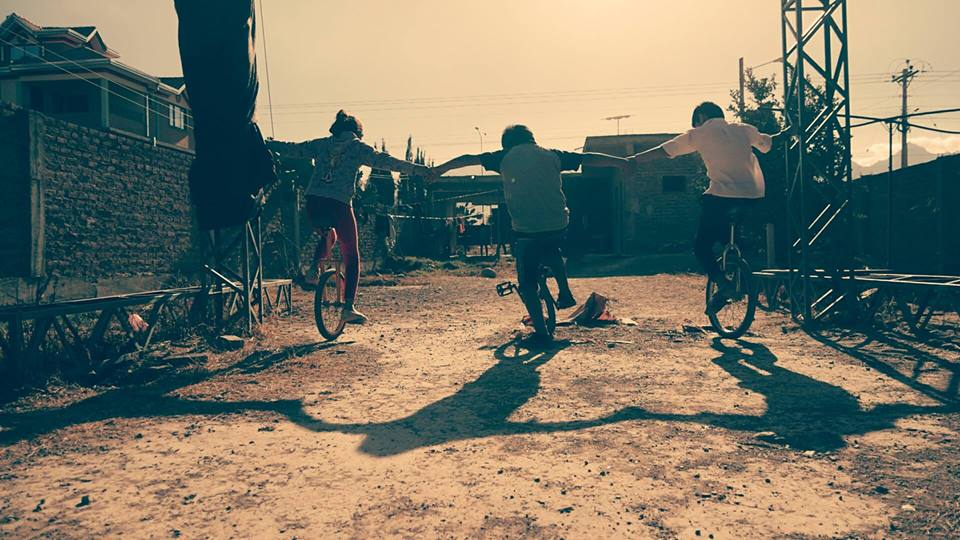Before I moved to Bolivia, I was pretty active in the European Burner scene. (Burners are people who attend Burning Man – a vast arts-focused festival in the Nevada desert built entirely by the participants, for the participants, with no paid entertainers. The movement has taken on a life of its own, and many Burners all over the world – including myself – espouse the values without ever having been to Burning Man.)
Each July, I used to head to the arid badlands of nothern Spain to take part in European burn event Nowhere, always volunteering in anything going to help run the event.
With working days of up to 17 hours, temperatures reaching nearly 50°C, storms, stomach bugs, trench toilets, and all kinds of other character-building “fun”, I don’t blame myself for occasionally finding my motivation flagging.
I admit that, at times when I found myself struggling to keep going, one thought kept passing through my head: “The people here aren’t exactly starving children, are they? Do they really need my “help”?”
In November 2015, I started working at Performing Life Bolivia (linking to Facebook because we update it more than our website), a foundation that genuinely did focus on children who had known homelessness, extreme poverty, child labour, and hunger – and I say focus on, because I know there are burners who have experienced these things. I expected that, once I met the children and started to perceive their reality, all my illusions about the wonders of burner events would melt away like a dream on waking.
Actually, the opposite happened: I came to appreciate the value of Burns more than ever before. I’m writing this to tell you why.
- Performing Life is currently running a crowdfunding campaign. To see more about our work and donate, please click here – Thank you!
At Performing Life (Fundación EnseñARTE in Spanish), we teach circus arts and music to children living in some of the most deprived areas of Cochabamba. In the music programme, some of the children live in prison with their parents.
Until I discovered the existence of Performing Life, I thought I was the only one who dreamed of uniting performing arts and social development this way. I thought everyone else in the world, with a few exceptions as rare as they are famous, must surely view the arts as a luxury. We should be giving these children anti-malarials! Medicine! Water! How can we justify giving them art when they have no running water? Priorities, people!
I think many people do view things this way – otherwise we would have more donors! And I’m not arguing that those causes aren’t important. But after two years at Performing Life, I have come to conclude that excluding the arts from development is an error of tragic short-sightedness.
What is this “social circus” stuff?
Performing Life is part of a global network of social circuses. If you don’t believe me, there is a map right here. Social circus can be explained as teaching or performing circus as a social intervention. Be it the Flying Seagull Project running circus projects to bring joy to refugees, Circability working with disabled people in New Zealand, or Mobile Mini Circus for Children operating from retrofitted shipping containers in Afghanistan, social circus is all over the world.
Social circus is excellent for teaching communication, teamwork, self-confidence, discipline, commitment, compromise, patience, expression, and many other skills and values. When a child first tries to get on a trapeze, it’s difficult and scary. They’re out of their comfort zone, exposed and visible up in the air. But their peers can help and support them, communicating carefully to explain tricks and making sure they don’t fall. After plenty of practice, they can perform a routine in public: something that previously seemed daunting, scary, and impossible has suddenly become possible, and they have earned respect in front of their peers, family, and community for doing it!
How does that relate to burn events?
Seeing the impact that access to the arts had on the young people we work with really brought home to me the immense value of communities which use the arts as a means to self-expression, exploration, building relationships with others, and above all, knowing oneself.
In two years, I have seen a lot of children arrive at the foundation as energetic, distracted, naughty little people, often with very sad stories to tell despite their young ages. As time goes by, they start to communicate, learn the value of co-operation and collaboration, and end up putting their all into blinding shows with legitimately impressive results. We have even helped a number of participants into university.
And this through a community that focuses on self-expression, exploration, building relationships with others, and knowing oneself – does that description sound familiar?
The 10 principles of Nowhere are:
- Self-expression
- Self-reliance
- No commerce
- Leave no trace
- Participation
- Inclusion
- Gifting
- Co-operation
- Community
- Immediacy
Many people, inside and outside the community, deride these as hippy idealism. But seeing many of these principles translated into a context of poverty and deprivation has shown me that they have real value far beyond the world of Nowhere.
As a Brit, I have grown up in a Stiff Upper Lip culture, and it is only very recently that we as a society are gaining a wider awareness and comprehension of the damaging effects this has on our mental health. We tend to think of being bad at self-expression as a peculiarly British problem, but it is as bad or worse in Bolivia.
Most Bolivians live in poverty. They have known real, chronic, gnawing hunger, worked from the age of six, lost loved ones young in the sort of preventable accidents and treatable medical conditions that are far rarer in the global north.
I don’t think I have ever heard anybody talk about their own pain, trauma, or depression in a social context here. Last week, I asked a boy who had just broken his wrist how he was, and he just said: “Fine”. It is as though, if one person gave an honest answer to the question “Cómo estás?”, it would open the floodgates to river of sorrows that each person carries inside, a flow of unbearable honesty that would never end. I know, because that’s how I feel when people ask me: “How are things in Bolivia?”
Burn events are laboratories where we can build an alternative society that enable us to explore values such as self-expression and good communication viscerally, with all our senses. They provide an invaluable space to explore self-expression, community-building, co-operating, and so many other things lacking in the London of rented housing, not knowing one’s neighbours, suspecting the unknown.
At Performing Life, like at Burner events, we encourage people to don costumes, paint their faces, and choose from lots of different circus disciplines to create acts that express what’s inside: some choose to put together elegant silks acts, while others create joy in themselves and others by doing clowning.
Maybe there are no official burns in Bolivia. But in many ways, at Performing Life our project is the same. We, too, work to create a space of exploration, where self-expression, co-operation, communication, inclusion, and untold other values that Burners consider their own come into the spotlight.
Interventions in medicine or infrastructure can certainly raise the level of development in a barrio, but to what extent do they help tackle root causes of problems such as delinquency, domestic violence, and social exclusion? Charity effectiveness assessment institution GiveWell’s list of recommended programmes (and it is an incredibly interesting website if you’re interested in donor efficacy, NGO myths, which programmes are worth supporting, etc) includes mosquito net distribution, iodizing salt, cataract surgery, and vitamin A supplementation.
These all sound awesome, but in my personal opinion, they will not tackle issues such as:
- Inability to communicate a perceived problem at home or in the workplace
- Difficulty relating to others
- Dealing with chaotic family situations
- Social exclusion
- Lack of intellectual stimulation (leading to boredom, leading to drug abuse, gangs, or whatever it takes to relieve that boredom)
- Lack of positive role models
That is why it’s so important to teach people about values. As this comic awesomely points out, the first thing dictators purge is philosophy, because learning human values such as critical thinking is vitally important to the robustness of any society.
Unfortunately, it is precisely these values that are often hard to measure empirically. GiveWell puts a strong focus on charities whose effectiveness can be easily demonstrated, but in social circus, given the intangible nature of the values we teach, researchers have often found it difficult to prove that improvements observed were solely down to circus.
What isn’t hard to see is the joy on the faces of the children as they learn new things: the first time they do a new trick; the glow after they perform; when a brilliant idea for a new act comes into their heads.
Parents and teachers say that Performing Life has made a huge difference to their children. One mum said during a meeting: “My daughter used to be shy, timid. But she’s changed since she came here. She doesn’t want to put the poi down now!”
A headteacher told us: “It’s incredible what some children whose behaviour isn’t the best… who am I kidding, who behave terribly in classes, can do when they get on stage.”
Another mum even said: “The Foundation makes me wish I was a girl again so I could go!”
While so radically different, we are the same. And to anyone who comes away from the Burn feeling that these values are a pile of hippy clap-trap, you’re most welcome to visit us in Bolivia.
- Performing Life is currently running a crowdfunding campaign. To see more about our work and donate, please click here – Thank you!







